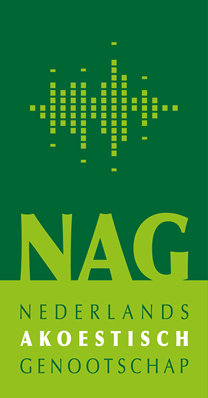Programma ALV en lezingendag
Datum: Woensdag 7 mei 2025 / Locatie: Eenhoorn Meeting Center, Amersfoort / Organisatie: Margriet en Reinier.
De ALV vindt dit jaar plaats bij Eenhoorn Meeting Center in Amersfoort (dit is recht tegenover station Amersfoort) op 7 mei 2025. Naast de ALV staat er een aantal lezingen van uiteenlopend karakter op het programma. Al met al voldoende akoestische stof om met elkaar over van gedachten te wisselen.
Dagprogramma:
- 10:00 Inloop, ontvangst met koffie en thee
- 10:30 ALV 1e deel
- 11:50 Een beter beoordelingskader voor geluid door meer rekening te houden met lage tonen – Erik Roelofsen, Nederlandse Stichting Geluidhinder
- 12:30 Lunch
- 13:00 ALV 2e deel
- 13:40 On solving the (convected) Helmholtz equation in terms of Xi – Ysbrand Wijnant, Universiteit Twente
- 14:20 Pauze met koffie/thee
- 14:40 De mogelijke bijdrage van elektromagnetische straling op de gewaarwording van laagfrequent geluid en op het gevoel van trillingen – Hugo Verhas, Hugo Verhas Akoestiek C.V.
- 15:20 Room average scattering coefficients – Dingding Xie, TU Eindhoven
- 16:00 Room acoustics for classical halls: Practice, theory and music, Nobody knows the sound of a C80 – Margriet Lautenbach, Acoustic Reflections
- 16:40 Borrel
Abstracts lezingen
Een beter beoordelingskader voor geluid door meer rekening te houden met lage tonen – Erik Roelofsen, Nederlandse Stichting Geluidhinder: Abstract volgt
On solving the (convected) Helmholtz equation in terms of Xi – Ysbrand Wijnant, Universiteit Twente: A range of models can be used to model noise propagation in the atmosphere; from very simple and not accurate (analytical/semi-empirical), to more complex and accurate (finite element/boundary element/parabolic equation). Although the latter methods are preferred, they are not used extensively as the computational cost is large. This primarily has to do with the restriction of needing at least some degrees of freedom per wavelength. In a recent approach, the author proposed to solve the Helmholtz equation in terms of a new (complex) variable ξ = α+iφ, where the pressure P = exp(ξ). Hence, α is a measure for the pressure’s amplitude and φ denotes the phase. As both α and φ are very smooth functions for predominantly propagating waves, and the smoothness is independent of the wavenumber, coarse meshes can be used to accurately describe the sound field for any wavenumber. This would allow a large number of wavelengths per element, as opposed to at least a number of elements per wavelength. In this paper, we extend this approach to include temperature variations and wind (convected Helmholtz). We will present the method and show results.
De mogelijke bijdrage van elektromagnetische straling op de gewaarwording van laagfrequent geluid en op het gevoel van trillingen – Hugo Verhas, Hugo Verhas Akoestiek C.V.: Naast het belang voor de juiste aanpak tot de vaststelling van hinder door laagfrequent geluid, dient men ook de aandacht te vestigen op de mogelijke bijdrage vanwege elektromagnetische straling op de gewaarwording van laagfrequent geluid en op het gevoel van trillingen. Het is een grensoverschrijdend thema en het leidt ertoe om op te roepen tot multidisciplinair en/of interdisciplinair onderzoek tussen neurologie, elektromagnetische straling en akoestiek.
Room average scattering coefficients – Dingding Xie, TU/e: Abstract volgt
Room acoustics for classical halls: Practice, theory and music, Nobody knows the sound of a C80 – Margriet Lautenbach, Acoustic Reflection: Room acoustics as a science is relatively young. When the Concertgebouw in Amsterdam was designed in the 1880’s, it wasn’t possible to hire an acoustician to join the design team. Knowledge about room acoustics started only a decade or so later, with the investigations of the well-known W.C. Sabine.
More than a century later it still feels that there is a lot to gain in the knowledge of room acoustics, especially for non-amplified music. In a hall for classical music, room acoustics is the main instrument to transfer the music form the musicians on stage to the listeners in the hall in the most beautiful way possible.
In this talk I want to reflect on different room acoustic aspects from the consultant (practical) point of view, being the bridge between musical goals and acoustical science. The design of a concert hall starts and ends with music. A client will emphasise his or her musical goals like sound quality, playing conditions on stage, surround sound and intimacy, presence and definition. In the design process the acoustic consultant has to mould these goals into numbers, parameters and models in order to transfer the musical objectives into architectural requirements and solutions. With reference to the design process of recently finished concert halls like Kulturpalast Dresden and Casals Forum Kronberg musical goals will be compared with the available acoustical knowledge from standards and literature, recent investigations and possible ways to think about acoustics and reflection patterns where proven knowledge still fails us.
Praktische informatie:
Deelname aan deze bijeenkomst is vrij voor leden van het NAG alsmede voor studenten. Voor niet‐leden zijn de kosten € 60,‐. Voor dit bedrag kunt u ook lid worden van het NAG voor het lopende kalenderjaar. Aanmelden is in alle gevallen vereist en kan hier.


